Introduction
AWS Lambda: Unleashing the Power of Serverless Computing
AWS Lambda represents a transformative approach to cloud computing, where the focus shifts from server management to pure code execution. This serverless model, embraced by industry leaders and innovative organizations, allows developers to deploy code that automatically responds to events. It is designed to scale automatically, billing only for the precise compute time used, offering a cost-efficient solution.
In this article, we will explore the capabilities of AWS Lambda and how it is being leveraged by companies like Chime Financial and Vertex Pharmaceuticals to drive innovation and operational efficiency. We will also delve into the key features of AWS Lambda, its use cases across various industries, and the benefits it brings to organizations. Additionally, we will discuss limitations and considerations when using AWS Lambda, as well as best practices for monitoring and managing costs.
Finally, we will explore advanced features and integrations and provide insights into troubleshooting and optimization.
By the end of this article, you will have a comprehensive understanding of AWS Lambda and its role in revolutionizing cloud computing. Whether you are a developer looking to harness the power of serverless computing or an organization seeking to innovate and streamline operations, AWS Lambda offers a compelling solution that aligns with the needs of dynamic applications and the ever-changing demands of the digital world.
What is AWS Lambda?
AWS Lambda represents a transformative approach to cloud computing, where the focus shifts from server management to pure code execution. This serverless model, embraced by industry leaders and innovative organizations, allows developers to deploy code that automatically responds to events. It is designed to scale automatically, billing only for the precise compute time used, offering a cost-efficient solution.
Chime Financial, a fintech company dedicated to creating helpful and free banking services, leverages this technology to enhance security and fraud detection. By analyzing patterns in transaction data, Chime's Risk Analysis team employs AWS Lambda to identify fraudulent activities, ensuring the protection of their customers' funds.
In the pharmaceutical sector, Vertex Pharmaceuticals employs serverless computing for drug discovery, where large datasets, such as microscope images, are analyzed using machine learning models. This has significantly expedited the analysis process, allowing scientists to focus on developing therapeutic solutions rather than labor-intensive data analysis.
Serverless computing's impact extends beyond the financial and pharmaceutical industries. For instance, neonatal neurotechnology firms use artificial intelligence to detect birth-related brain injuries in infants, and environmental organizations analyze satellite imagery to monitor deforestation. These applications demonstrate the versatility and agility of serverless computing in addressing real-world challenges.
As AWS Lambda continues to evolve, it integrates with advanced AI models for enriched voice interactions and smart home experiences, signifying its role in shaping the future of technology. While serverless computing offers numerous advantages, such as reduced operational overhead and scalability, it also presents unique challenges. Database connections, for instance, require careful consideration in a serverless environment.
By embracing serverless computing, developers and organizations can harness its full potential to innovate and address complex problems more efficiently, ultimately driving progress across various industries.
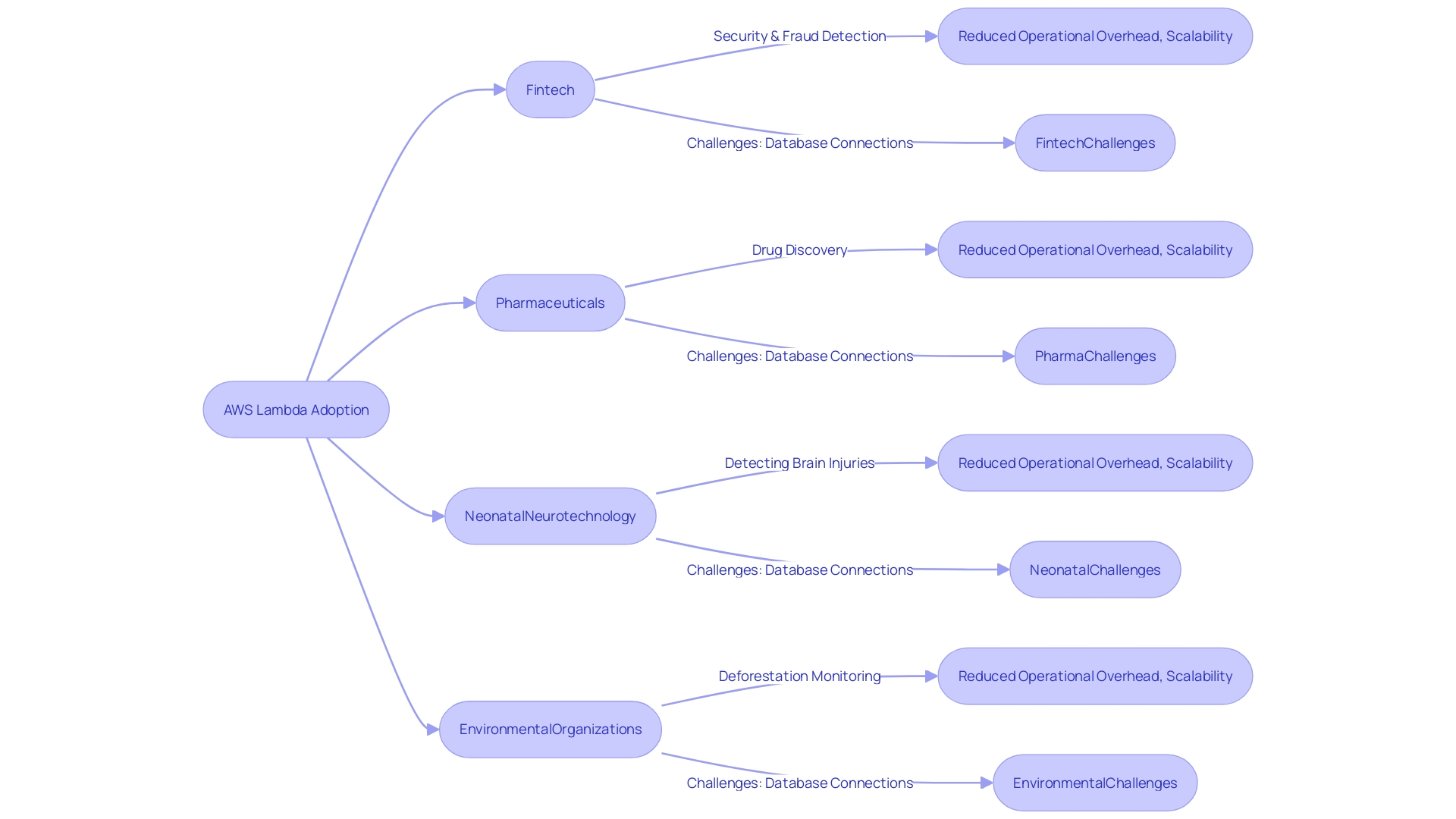
How AWS Lambda Works
AWS Lambda is a serverless compute service that allows developers to run code in response to events without provisioning or managing servers. When you upload your function code in languages like Python, Node.js, or Java, Lambda takes care of everything required to run and scale your code with high availability. This serverless paradigm is exemplified by companies like Chime and Vertex Pharmaceuticals, which have leveraged AWS Lambda to drive innovation and operational efficiency.
Chime, a technology-driven financial company, uses AWS Lambda to safeguard their member accounts against fraudulent activities by continuously analyzing transaction patterns. Likewise, Vertex Pharmaceuticals integrates AWS Lambda for drug discovery, utilizing machine learning to process and analyze vast datasets, significantly accelerating research outcomes. These examples underscore the power of AWS Lambda's event-driven architecture, which offers a pay-as-you-go pricing model that ensures you only pay for the compute time you consume, optimizing both cost and performance.
Key Features of AWS Lambda
AWS Lambda is integral to modern cloud computing, enabling the development of responsive and scalable applications with its event-driven architecture. This service seamlessly scales to match demand, with each function triggered by AWS events, such as modifications in Amazon S3 or updates in DynamoDB. This responsiveness is a cornerstone of Lambda's architecture, which allows for the construction of applications that react swiftly to changes and user interactions.
The financial efficiency of AWS Lambda is one of its most compelling attributes. The service's pay-per-use pricing structure means that you incur costs only for the actual compute time your functions use. This can be a significant cost-saving measure, especially when compared to the potential expenses of maintaining idle server capacity.
Beyond its scalability and cost-effectiveness, AWS Lambda provides robust logging and monitoring features, simplifying the tracking and troubleshooting of function executions. These built-in capabilities offer valuable insights and real-time data that can help optimize performance and maintain the reliability of your applications.
Lambda's capabilities are not just theoretical but have been proven in practice. Adadot, a company focused on processing large volumes of developer data, leveraged Lambda's scalability to accommodate their growth without needing to predict system requirements far in advance. Their experience underscores Lambda's capacity to handle unexpected traffic surges, a critical factor for businesses aiming to maintain performance during peak times.
In the broader landscape, AWS Lambda and similar services are driving innovation by providing tools that address complex problems. For instance, organizations are using machine learning to sift through massive datasets, like the 88 million digital files reviewed for signs of abuse in 2022, a task expedited exponentially by such technologies.
As cloud computing evolves, AWS Lambda continues to stand out, offering a combination of flexibility, scalability, and efficiency that aligns with the needs of dynamic applications and the ever-changing demands of the digital world.
Creating and Managing Lambda Functions
AWS Lambda, a cornerstone of serverless architecture, offers a platform for developers to run code in response to events without the need to manage servers. Getting started with Lambda involves a few key steps. Initially, you need to author your function code, which can be done in the AWS Management Console, or programmatically via the AWS CLI or SDKs.
This code can handle diverse tasks, from processing data streams to integrating with other AWS services.
Once your code is ready, you set up the necessary triggers, which could range from changes in data states within AWS services to HTTP requests via Amazon API Gateway. This integration with API Gateway, for instance, allows for the creation of scalable and secure serverless APIs. Moreover, defining the appropriate permissions ensures that the function has access to the resources it needs while maintaining security best practices.
Monitoring and troubleshooting are integral to the Lambda experience. AWS provides tools to track the function's performance metrics and logs, making it easier to optimize and debug. This real-time data is vital to grasp how your functions are performing and to react swiftly to any issues that arise.
Lambda's application reaches far beyond simple function execution. For example, it enables the construction of serverless email solutions that utilize AWS Simple Email Service (SES) to send mass communications efficiently. With a setup that can be ready within minutes, Lambda streamlines processes that traditionally required significant capital investments in hardware and software.
The versatility of AWS Lambda is further exemplified by its role in the cultural heritage community, where it has been used to share digital collections globally. This showcases Lambda's ability to support applications that require scalability, reliability, and integration with other AWS services.
As we navigate the intricacies of AWS Lambda, we're reminded of the profound impact that cloud computing is having on the software world, driving us towards a future where operational overhead is minimized and the full potential of code is realized.
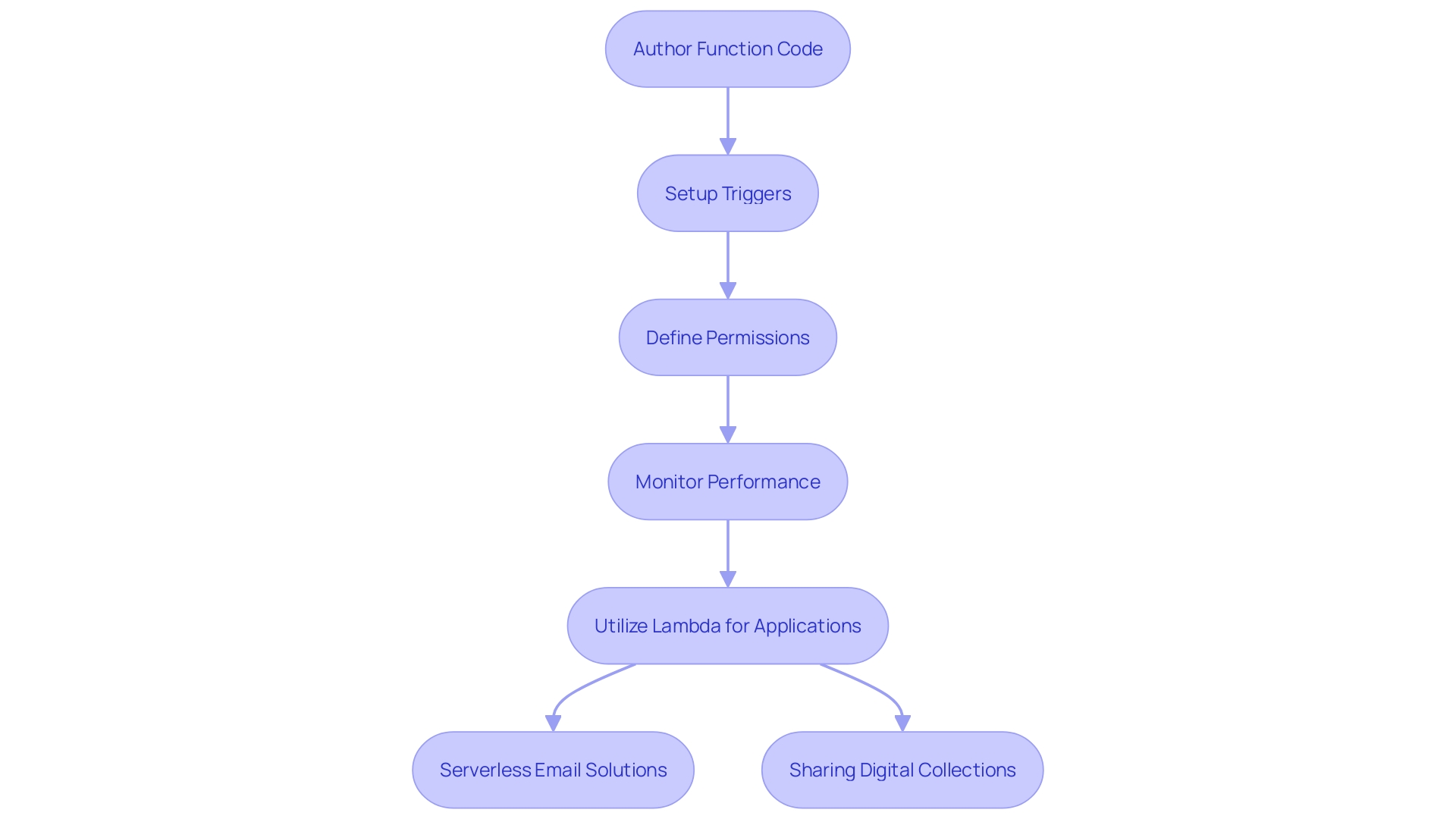
Use Cases for AWS Lambda
AWS Lambda's versatility shines across numerous applications, empowering businesses to innovate and optimize their processes. For instance, Chime Financial leverages Lambda for real-time risk analysis to safeguard customer transactions, demonstrating Lambda's capacity for immediate data processing and pattern recognition. Similarly, Vertex Pharmaceuticals employs Lambda in conjunction with machine learning to accelerate drug discovery, analyzing vast datasets and microscope imagery to identify therapeutic candidates more efficiently than ever before.
Lambda also enables serverless backends, facilitating smooth user experiences for web and mobile applications through rapid data processing and authentication procedures. This aligns with the shift towards cost-effective, scalable, and sustainable architectures, as emphasized by AWS thought leaders, who advocate for considering cost as a fundamental aspect of development.
Furthermore, Lambda's data transformation capabilities enhance ETL workflows, seamlessly converting data formats to empower analytics and decision-making. In the realm of IoT, Lambda processes data from a myriad of devices in real-time, unlocking potential in fields such as home automation and industrial monitoring, much like organizations using AI and Lambda for environmental tracking and safeguarding children online.
As these use cases illustrate, AWS Lambda stands as a cornerstone for modern businesses aiming to advance their technological capabilities, streamline operations, and foster innovation, all while maintaining a keen eye on cost and sustainability.
Benefits of Using AWS Lambda
AWS Lambda, a flagship serverless computing service from Amazon Web Services, has been a game-changer for organizations like Chime Financial and Vertex Pharmaceuticals. It provides a seamless platform where operational management such as server provisioning and patching is fully abstracted, allowing teams to focus solely on coding and innovation. With its automatic scaling capabilities, Lambda functions are always ready to meet demand, handling any volume of requests without the need for manual scaling efforts.
Financial technology leader Chime has leveraged AWS Lambda to ensure the security of their member accounts, closely monitoring transaction patterns to detect fraudulent activity with the scalability and efficiency that Lambda provides. Vertex Pharmaceuticals has also utilized Lambda in their drug discovery process, applying machine learning to analyze vast datasets and microscope images, expediting the traditionally time-consuming analysis phase.
The cost benefits of AWS Lambda are underscored by GoDaddy's experience, with over 20 million customers harnessing insights from data to drive business decisions. Lambda's pay-per-use pricing model ensures that companies like GoDaddy only pay for the compute time they consume, avoiding any unnecessary expenditure on idle resources. This model has significantly contributed to GoDaddy's commitment to operational efficiency and optimization of batch processing jobs.
Furthermore, AWS Lambda's ability to accelerate the time-to-market is critical in today's fast-paced tech landscape. The service's ease of deployment enables rapid iteration and deployment, which is essential for companies intent on delivering new features swiftly and staying ahead of the curve.
In the broader context of cloud computing, AWS Lambda represents just one of the innovative solutions from AWS, sitting alongside other services like AWS Fargate. The choice between Lambda and Fargate hinges on the specific needs and workloads of an organization, with each offering distinct advantages. AWS Lambda’s serverless approach offers reduced operational overhead and cost efficiency, while AWS Fargate provides a containerized solution for applications that require more control over the computing environment.
As the cloud computing landscape evolves, with advancements like Amazon S3 Express One Zone and Graviton processors, AWS continues to push the envelope, offering solutions that cater to the diverse and growing needs of the tech community. The journey into serverless computing with AWS Lambda brings its own set of challenges, but the transformative benefits of reduced operational overhead, scalability, and cost efficiency are compelling for companies seeking agility and innovation.
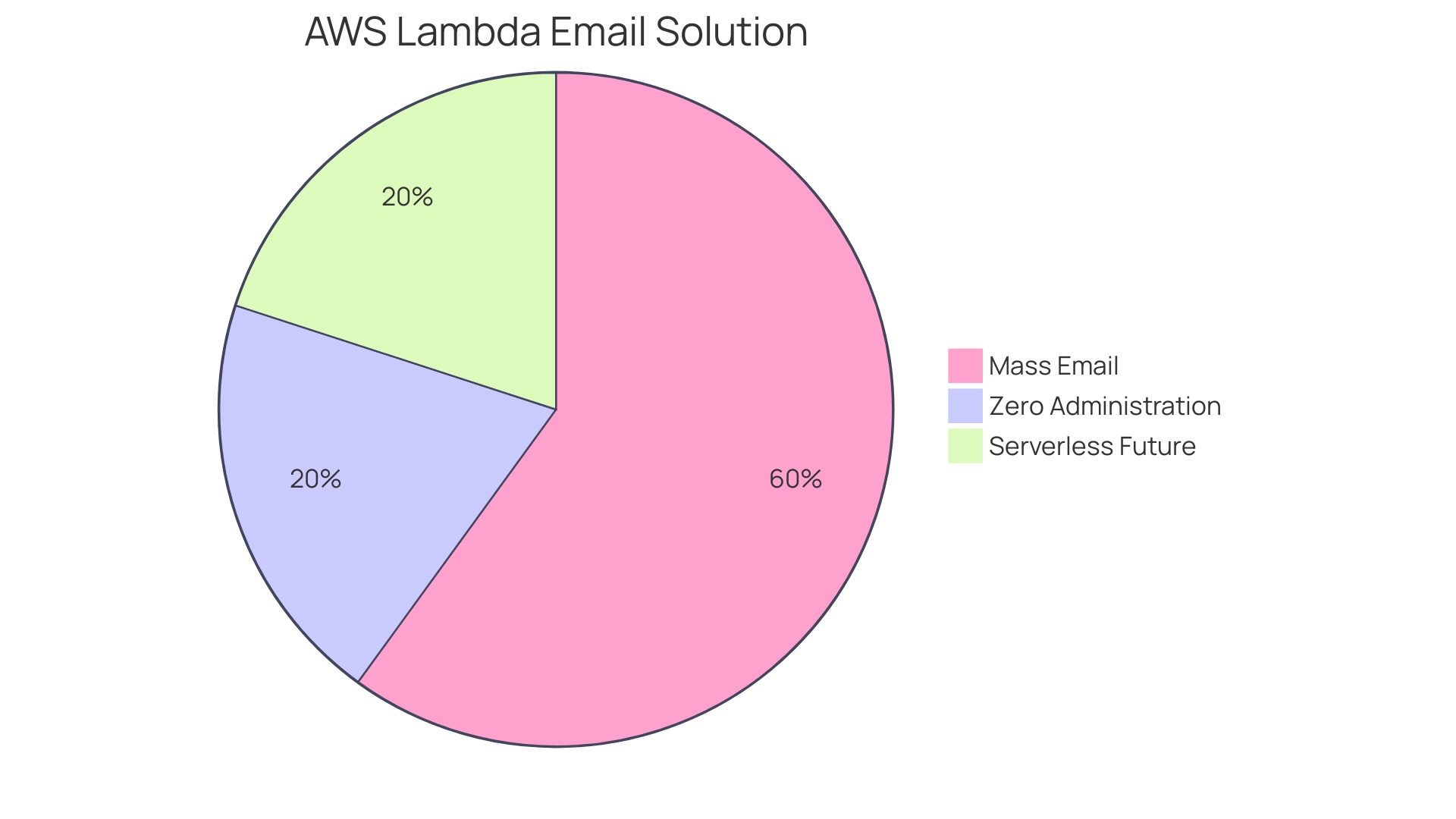
Limitations and Considerations
AWS Lambda is a powerful service that enables developers to run code without provisioning or managing servers, scaling automatically with the precise amount of computing power needed. When it comes to utilizing AWS Lambda, it's crucial to acknowledge certain limitations and considerations to optimize your functions effectively.
Execution Limits: AWS Lambda functions come with execution limits that can impact their duration, memory, and disk space. To ensure your functions operate within these constraints, it's imperative to design and monitor their resource utilization meticulously. For instance, Chime Financial, an innovative FinTech company, leverages AWS Lambda for their risk analysis operations by carefully tuning their functions to work within Lambda's execution limits while effectively monitoring transaction patterns for fraud detection.
Cold Start: Occasionally, Lambda functions may incur an initial latency due to cold starts—particularly after a period of dormancy or upon first invocation. This latency can affect time-sensitive applications, necessitating strategies to mitigate cold starts. Companies at the forefront of technology, such as Vertex Pharmaceuticals, employ AWS Lambda for drug discovery processes, where managing cold starts is critical for the timely analysis of experimental data using machine learning models.
State Management: By nature, AWS Lambda functions are stateless, not retaining any state between invocations. Applications requiring stateful behavior must integrate with external storage solutions or databases to maintain state. In complex systems where multiple Lambda functions interoperate, like those in financial services or pharmaceutical research, robust state management is essential for seamless functionality.
Integration Complexity: Orchestrating multiple Lambda functions and managing their interdependencies can present challenges. Thoughtful architectural design is key, and tools like AWS Step Functions can simplify the orchestration of workflows, ensuring a cohesive and manageable serverless ecosystem. The advancements in AWS Lambda, as discussed at conferences like QCon, highlight the importance of understanding the underlying infrastructure and invoke routing layers to design effective and efficient serverless architectures.
In conclusion, while AWS Lambda offers a suite of advantages for serverless computing, being cognizant of its limitations is vital for technology leaders and developers. By addressing these considerations with strategic planning and leveraging the right tools, organizations can harness the full potential of AWS Lambda to drive innovation and maintain competitive edge in their respective industries.
Getting Started with AWS Lambda
Embarking on the journey of AWS Lambda involves more than just having an AWS account; it's about unleashing the potential of serverless architecture to innovate and scale efficiently. AWS Lambda represents a paradigm shift, providing a platform where you can deploy functions that automatically scale to meet the demands of your application, without the need for managing servers. To illustrate, Chime Financial, a FinTech company, leverages AWS Lambda to safeguard their members from unauthorized transactions, showcasing how serverless functions can be used for real-time fraud detection and enhancing security.
Through AWS Lambda, you can create database tables with Amazon DynamoDB that handle immense amounts of data and traffic with consistent performance. This is crucial for companies like Vertex Pharmaceuticals, who apply machine learning to analyze vast datasets, such as microscope images in drug discovery research. AWS Lambda's ability to execute code in response to events and automatically manage the underlying compute resources makes it an invaluable asset for such computationally intensive tasks.
As you embark on creating your Lambda functions, you'll find AWS's comprehensive resources guiding you through each step. The process is streamlined with tutorials and examples, facilitating the deployment of serverless Python functions using the Serverless Framework, as detailed in AWS guides. Such resources underscore the importance of solving problems effectively without getting entangled in abstractions, as efficiency is key in engineering solutions.
The simplicity of AWS Lambda is also reflected in its cost-effectiveness. For instance, deploying a serverless email solution with AWS Lambda and Simple Email Service (SES) can significantly reduce the capital investment typically required for traditional communication infrastructures. This efficiency extends to the operational side, where AWS Lambda's observability features allow for precise monitoring and quick adjustments to meet changing requirements and metrics.
As AWS continues to innovate, the choice between AWS Lambda and other services like AWS Fargate will depend on your specific project needs, ensuring that AWS's suite of services aligns with the unique challenges and goals of your organization.

Configuring and Deploying Lambda Functions
Setting up AWS Lambda functions is a multifaceted process, encompassing the writing of the function's code, the establishment of triggers that initiate the function, and the adjustment of permissions necessary for its operation. A range of deployment strategies is supported by AWS Lambda, enabling versatility in the way functions are delivered and updated. Direct uploads of code for immediate deployment, utilization of deployment packages for version control, or integration with code repositories such as AWS CodeCommit or GitHub for continuous integration and delivery are among these methods.
For example, using AWS Lambda in conjunction with database triggers can create powerful, automated workflows. Consider the use case where AWS Lambda, in conjunction with Amazon Comprehend, is employed to detect personally identifiable information (PII) in database entries. When new data is inserted into the database, a Lambda function is triggered, which then utilizes Amazon Comprehend to identify any PII.
Upon detection, an Amazon Simple Notification Service (Amazon SNS) alert can be configured to notify the relevant personnel. This setup does not require any alterations to the application layer and can be applied to various applications, including those where the source code is not accessible.
Moreover, AWS Lambda's role in processing IoT data and automating tasks based on schedules or events showcases its flexibility. By logging into the AWS Lambda dashboard within the AWS Management Console, users can navigate the interface to configure and manage Lambda functions efficiently.
From combating global issues with AI, as in the case of organizations using machine learning to track environmental changes or to identify signs of abuse in vast amounts of digital data, to the necessity of cost-aware and sustainable architecture emphasized by industry experts, AWS Lambda is at the heart of modern, serverless computing. It empowers developers to write the future of the cloud, one function at a time, without the hindrances of operational overhead.
An insightful quote to consider in this context is: 'Solve the problem you need to solve, donât get tangled up in how to abstract or generalize the solution, just get it done in the simplest way possible.' This encapsulates the essence of AWS Lambda's value proposition—providing a straightforward, effective means to execute code in response to events, streamlining the path from problem to solution.
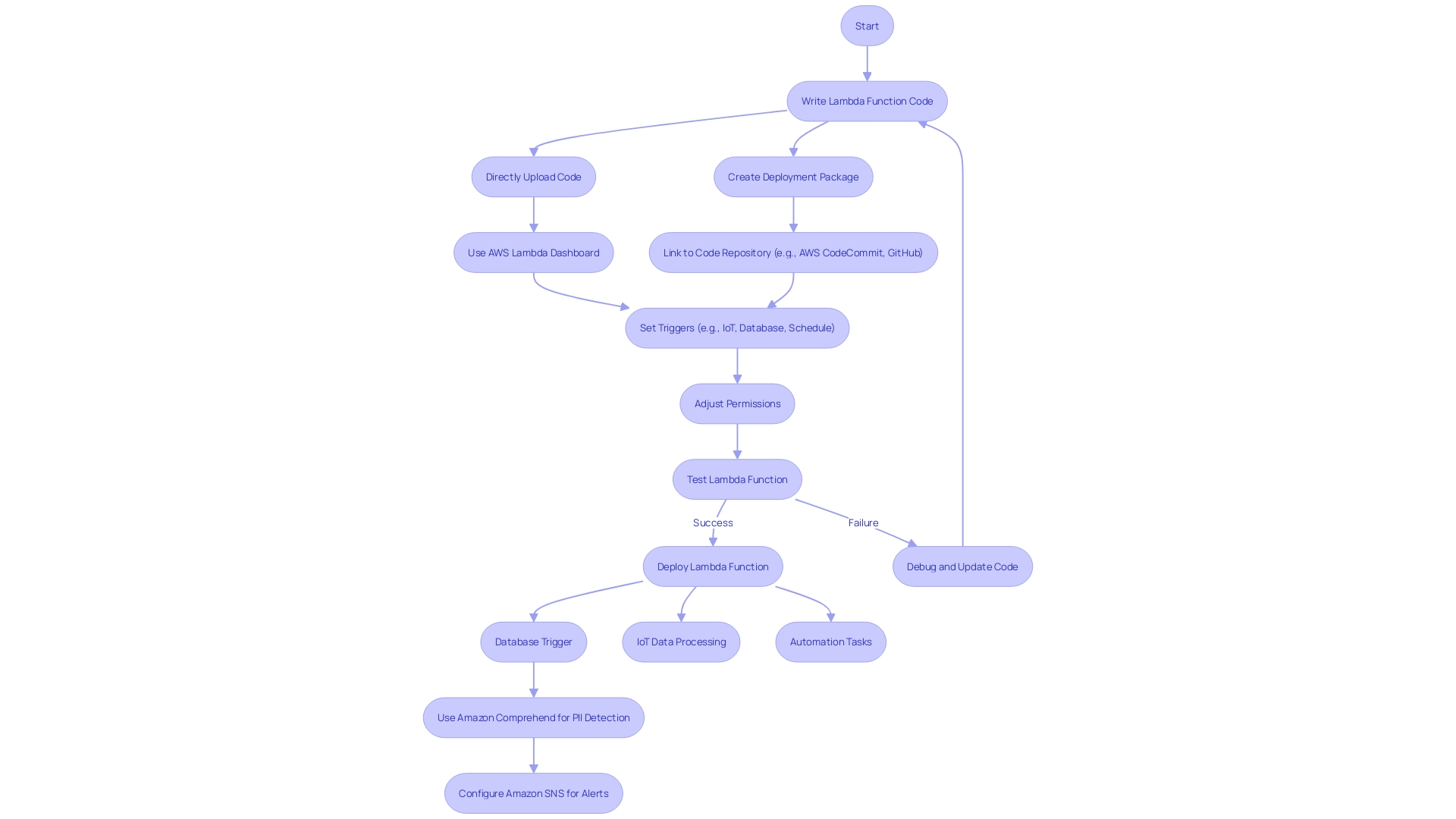
Monitoring and Managing Lambda Costs
Effective cost management is a crucial aspect of running serverless architectures, such as those utilizing AWS Lambda. With the integration of financial management and technology, organizations can navigate the cloud model of consumption and optimize their investment. The Cost Optimization pillar of the Well-Architected Framework outlines a continuous improvement pathway across various project phases.
This includes the establishment of a collaboration between finance and technology leads—such as CFOs, financial controllers, and technology product owners—to create a cohesive strategy that aligns technology spend with business outcomes.
AWS equips users with tools like AWS Cost Explorer and AWS CloudWatch to facilitate the vigilant monitoring and management of Lambda function costs. By setting up alarms and crafting custom metrics, businesses can gain granular insights into usage patterns and expenses, enabling them to implement cost-effective measures. Optimizing function memory allocation and minimizing extraneous invocations are practical steps that can lead to significant cost reductions.
Additionally, staying abreast of the latest technological advancements, such as AI and machine learning innovations presented at AWS re:Invent, can provide new avenues for cost optimization and efficiency within serverless environments.
In the realm of serverless computing, every function and resource provision must be scrutinized for cost-effectiveness to ensure that the organization's investment in technology brings the maximum return. It is this meticulous attention to detail in the financial and operational aspects of AWS Lambda usage that enables the achievement of desired business goals while maintaining a cost-aware infrastructure.
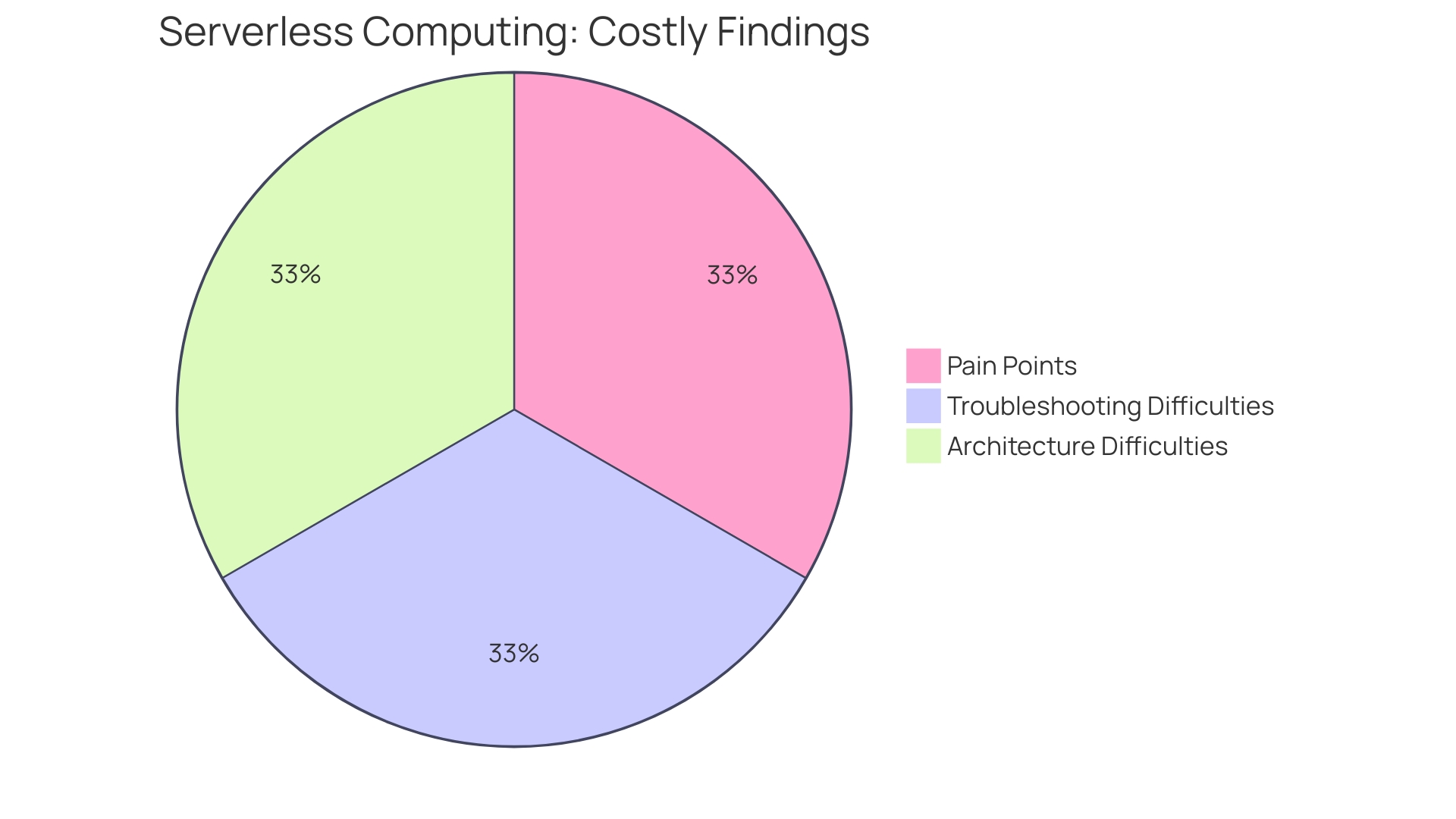
Advanced Features and Integrations
AWS Lambda's suite of features provides the functionality needed to build sophisticated applications that are both scalable and cost-effective. By leveraging Virtual Private Cloud (VPC) support, developers can ensure that their Lambda functions operate within a secure, isolated section of the AWS Cloud. This is essential for applications that handle sensitive data or require additional security measures.
Moreover, environment variables in Lambda allow developers to adjust the behavior of their functions without altering the code, making it easier to manage across different stages of development. Versioning and aliases are also invaluable, as they enable developers to easily manage and roll out updates to their functions, ensuring that applications remain up-to-date with the latest business logic and features.
Integration with other AWS services is a cornerstone of Lambda's appeal. For example, combining Lambda with Amazon DynamoDB enables serverless architectures that can scale automatically with demand. Similarly, integrating with Amazon Simple Notification Service (SNS) and AWS Step Functions can facilitate complex workflows and communication patterns within applications, allowing for asynchronous processing and coordination between microservices.
The power of AWS Lambda is evident in real-world applications. Organizations are leveraging Lambda to tackle a variety of challenges, from automating customer email responses using Amazon Bedrock to sending mass emails efficiently with Simple Email Service (SES). AWS Lambda has also been integral to the deployment of machine learning models that sift through millions of files to detect instances of sexual abuse against children, significantly reducing the time required for such critical analyses.
These applications demonstrate the versatility and strength of AWS Lambda in enhancing and simplifying operations across different domains, from marketing and customer service to social impact and environmental monitoring. As software continues to shape our world, AWS Lambda stands as a key enabler of innovation, empowering organizations to create robust, responsive, and efficient digital solutions.
Best Practices and Troubleshooting
Optimizing AWS Lambda functions is critical for maintaining high performance and reliability. Consider a scenario where a Lambda function is tasked with fetching a list of NFL stadiums from an Amazon Aurora database, returning the data as a JSON object. This use case requires the function to execute rapidly (in under 10ms) and scale to handle a large number of transactions per second.
Through meticulous optimization, the performance of such a function can be remarkably improved, although this process is often more intricate than it initially appears.
The optimization journey involves a series of nuanced decisions, focusing on key aspects such as memory allocation and timeout settings. Efficient error handling and strategic implementation of retries are also pivotal, ensuring robustness and resilience. Additionally, thorough monitoring of function logs and metrics plays a vital role in maintaining an oversight of the function's performance, enabling prompt identification and resolution of any arising issues.
When challenges occur, AWS offers a wealth of documentation and support resources, designed to assist in problem-solving. The AWS community, including forums and conferences like QCon, serves as a platform for sharing insights and best practices. For example, the serverless best practices shared via the sls-mentor tool, which evaluates AWS serverless projects, can guide architects and developers in building more efficient, cost-effective, and scalable serverless applications.
This comprehensive approach to optimization not only enhances the performance of individual functions but also contributes to the overall effectiveness and efficiency of serverless architectures in AWS environments.
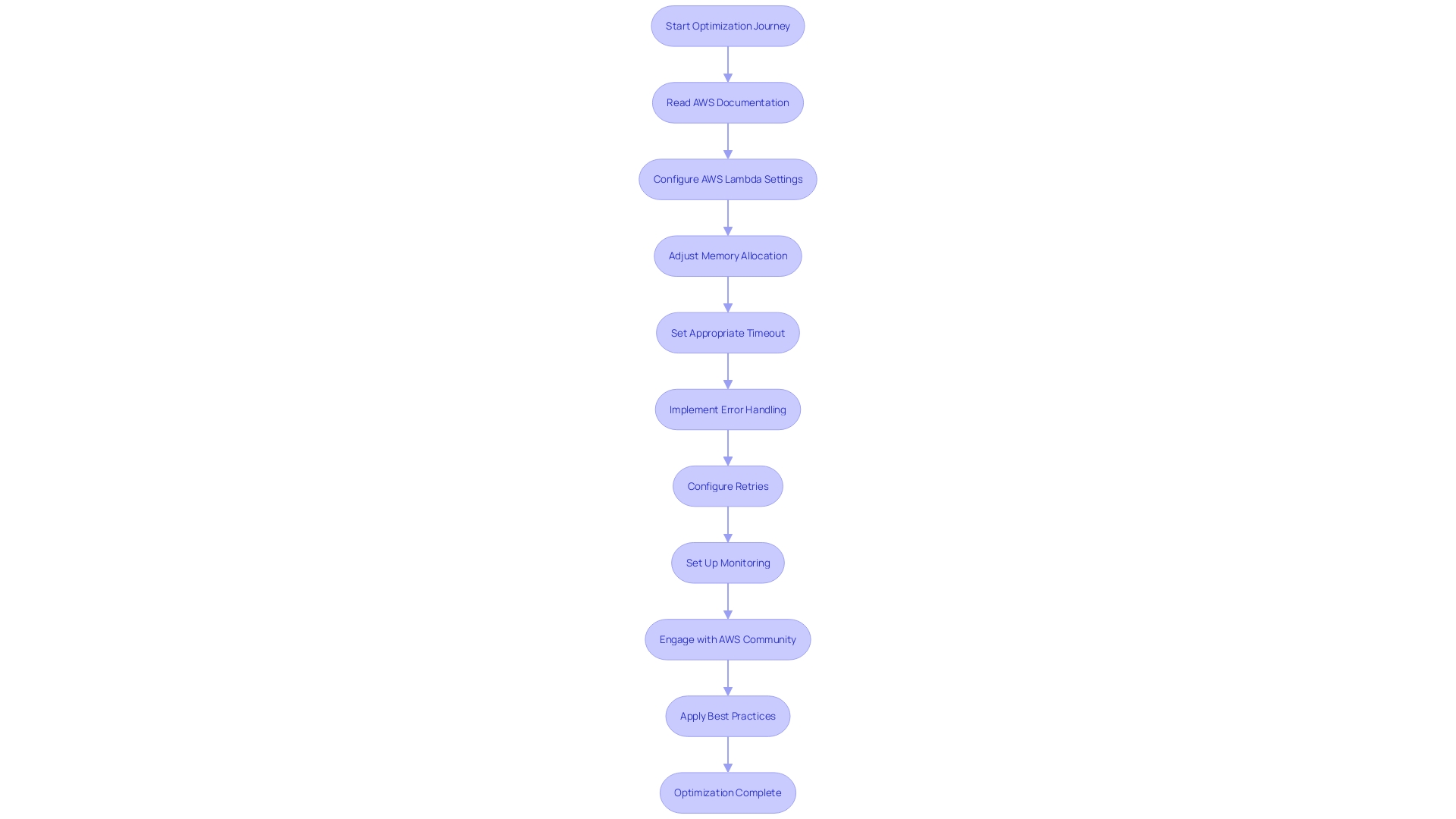
Conclusion
AWS Lambda is a transformative solution for cloud computing, enabling developers to deploy code that automatically responds to events, scales automatically, and bills only for the compute time used. Companies like Chime Financial and Vertex Pharmaceuticals are leveraging AWS Lambda to drive innovation and operational efficiency.
With its event-driven architecture, AWS Lambda allows for the development of responsive and scalable applications. The pay-per-use pricing structure ensures cost efficiency, while robust logging and monitoring features provide valuable insights for optimizing performance.
AWS Lambda's versatility is evident in its use cases across various industries, such as real-time risk analysis, drug discovery, serverless backends, data transformation, and IoT data processing. This empowers businesses to innovate and optimize their processes.
Using AWS Lambda offers several benefits, including abstracting operational management, automatic scaling capabilities, cost efficiency, and accelerated time-to-market. It simplifies the deployment process and allows for rapid iteration and deployment.
While AWS Lambda offers numerous advantages, it's important to consider its limitations, such as execution limits, cold starts, state management, and integration complexity. Addressing these considerations with strategic planning and leveraging the right tools is crucial for maximizing the potential of AWS Lambda.
Getting started with AWS Lambda is user-friendly, with comprehensive resources and tutorials provided by AWS to guide users through the process.
Monitoring and managing Lambda costs is essential for running serverless architectures effectively. AWS offers tools for vigilant cost monitoring and optimization strategies to reduce unnecessary expenditure.
AWS Lambda's advanced features and integrations, such as VPC support and environment variables, provide the functionality needed to build sophisticated applications. Integration with other AWS services enhances its appeal and enables scalable architectures and complex workflows.
In conclusion, AWS Lambda revolutionizes cloud computing by shifting the focus to pure code execution. Its key features, versatility, and benefits make it an essential tool for developers and organizations seeking innovation and operational efficiency. By leveraging AWS Lambda, organizations can unlock the full potential of serverless computing and drive progress in their respective industries.




